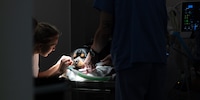
Background information
Swallowed underpants and hip prostheses for cats: a day at the animal hospital
by Darina Schweizer

They spend their days sniffing out ecstasy, meth and cocaine, tracking down money and searching for missing persons. Meet Anora and Diara, the Zurich Cantonal Police dogs who can find anything and anyone.
It’s quiet. The only sound to be heard is the occasional call of a great tit, echoing from the woods behind the Dübendorf Service Dog Centre. It’s hard to believe such a significant number of Switzerland’s 610 police dogs are trained at this facility, an area almost the size of two football pitches. Last year, the centre trained 33 of the country’s 99 canine recruits. And somehow, I’m not hearing a peep out of them.
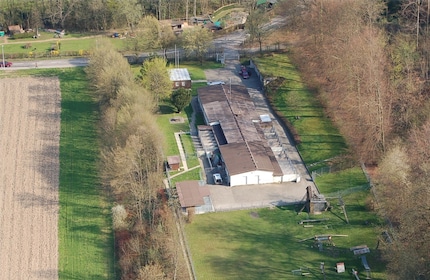
«Most of them are working, training or at home. They’ve got families too, you know?» says Jörg Guggisberg, who greets me. The 52-year-old, who heads up the Zurich Cantonal Police’s service dog unit, has brought his own dogs to meet me. There’s Anora, a criminal investigation dog who tracks down drugs and money, and Diara, who hunts down people. The two pooches have a big day in store for them, as we’ll be sending them off to sniff out drugs, banknotes and a missing person.
We slowly approach a white van with the two dogs waiting inside. Right on cue, we start to hear loud barking. As Guggisberg opens the rear doors and then the dog crate, I’m expecting to be confronted with an imposing Dobermann. The dog that jumps out of the vehicle, however, is more likely to an inspire an «awww» from anyone looking at her. Four-year-old Anora, a shaggy Large Munsterlander, greets me with a joyful wag of her tail.
This unassuming-looking pooch is about to be put to the test. Guggisberg has stashed some drugs in a black van around the back of the building. Anora’s job? To track them down. She prances around beside Guggisberg like Bambi. «She’s by far the most spirited dog I’ve ever had,» he says with a laugh. «Until she goes to work,» he adds in a serious tone. As soon as Guggisberg puts the neon-orange drug-and-money collar on Anora, her excitability immediately dies down. She knows it’s time to get to work.
Anora’s focused on a single target: the drugs in the vans. Upon her owner shouting «search!», she shoots off like an arrow. She begins systematically sniffing her way around the van in a process known as free searching. This basically means she hasn’t been given any clues. Less than ten seconds later, the dog stops and lies down on the ground by the back wheel. This is the sign she’s found the ecstasy capsule. «Good!» says Guggisberg tenderly, slipping her a treat.

The search picks up again. Anora quickly sniffs her way to the footwell of the van and stops again. This is where the crystal meth is hidden.
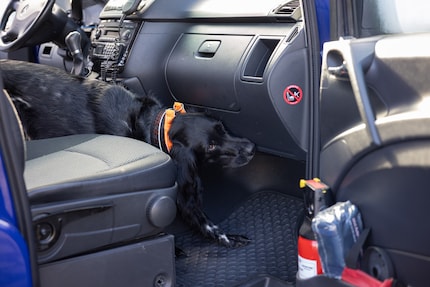
After another treat, the search continues. This time, it’s a controlled search. Guggisberg pulls out a stick with a small, coloured knob on the end of it. He uses it to show the dog where to look: in this case, under the open bonnet. When he taps on it, Anora jumps onto the engine.
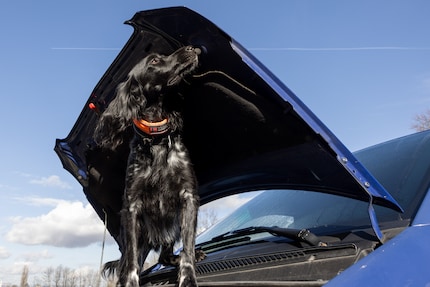
Staying up there is no easy feat. The dog keeps having to use her paws to regain her balance. «She learned to do that on the training ground,» explains her owner, pointing at a large stretch of grass behind him. It’s where the service dogs navigate obstacles such as transparent grids or wobbly surfaces during their training. Using a ladder leading up to a little wooden house, they become accustomed to being carried or pushed through a window.

In the meantime, Anora’s found what she was looking for and shows us the cocaine wedged between the battery and the brake fluid. It’s time for a break. After all, as far as the dog’s concerned, this was a real police operation, not a drill. The air-conditioned van’s already waiting for her.
When we’re standing in front of it, Guggisberg simply uses a finger to tell Anora to sit. I’m amazed at how calmly – and how little – he communicates with her. «You don’t need to use a stern tone. The important thing is giving clear commands. If you give ambiguous, inconsistent signals and blabber on at the dog, it’ll soon stop listening to you,» he says. He then adds with a grin, «The same thing happens to me.»
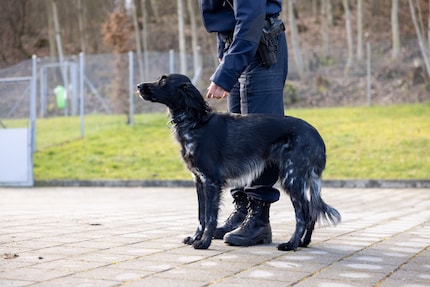
Guggisberg has trained five service dogs of his own. There are two categories of police service dogs. Protection dogs are mainly used in non-peaceful situations, and to protect people and property. They’re used, for example, to patrol the airport for the World Economic Forum (WEF). Sniffer dogs are deployed to find narcotics, banknotes, explosives, incendiary devices, data carriers or missing persons. They’re also deployed as criminal investigation dogs, for example to track down corpses or traces of blood or sperm at suspected crime scenes.
Once the dogs are ten weeks old, Guggisberg collects them from certified breeders who work with the police. «When I select them, I make sure they can deal with being around people and that they’re very willing to work,» he explains. More specifically, they need to be attentive, able to focus and have the ability to navigate their surroundings freely and confidently. Playfulness also stands them in good stead. «It makes it easier for them to get excited about training – Anora’s like that,» he says with a laugh.
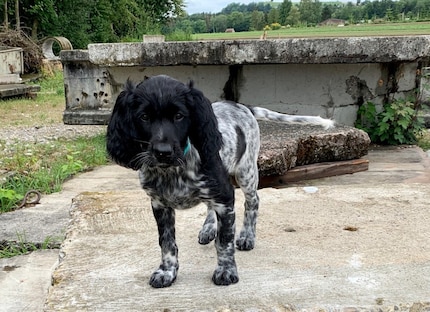
After acclimatising them for a week or two at home, Guggisberg gets the pups familiar with various environmental stimuli. «We take trains and buses together, get into crowds and go to noisy places. The dogs learn how to stay calm and not get distracted or frightened. Then, we start playing games to improve obedience and search skills, things we work on continuously.» Real samples are used to train the animals to recognise specific odours such as drugs. Sniffer dogs take two years to become fully trained.
I’m curious to know whether certain dogs get suspended or have to drop out of the programme. According to Guggisberg, this is very rare. «It’s a low, single-digit percentage every year.» When there are drop-outs, he says, it’s usually because of the handlers. Perhaps a family member develops a dog allergy or the police officer is under too much strain. It’s almost never down to the dog failing to perform well. What’s more, annual assessments make sure the dogs stay on track.
Ten minutes later, Anora’s been walked and is ready for her next mission in the command centre, where Guggisberg has hidden some banknotes. In real life, these would usually be sought out in the case of a financial crime. He sends Anora off with a shout of «search!»
The dog begins systematically sniffing her way around the room. Every so often, she points her snout into the air to catch the scent. She’s been trained to do this in a similar way to sniffing out drugs – by being conditioned to a specific odour. «The Swiss National Bank provided us with the raw materials present in banknotes. We take a similar approach to data carriers such as smartphones. We get the individual materials used to manufacture storage media from ETH Zurich,» explains Guggisberg. Anora’s already found what she was looking for. She stops under the blackboard, where Guggisberg proceeds to pull out a wad of cash. He praises the dog.
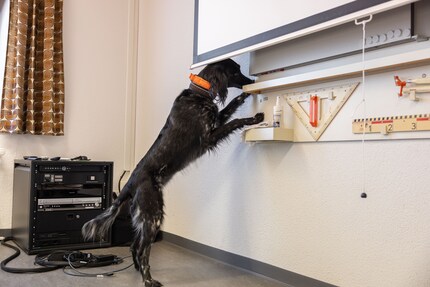
A few seconds later, the dog heads for a small cupboard. It’s locked, but she seems to have got wind of something in there. Guggisberg pulls open the sliding door, and Anora goes on sniffing. Happening upon a little cardboard box right at the back, she indicates she’s found something. I can literally feel the dog’s eagerness to tear open the container. But she resists the temptation.
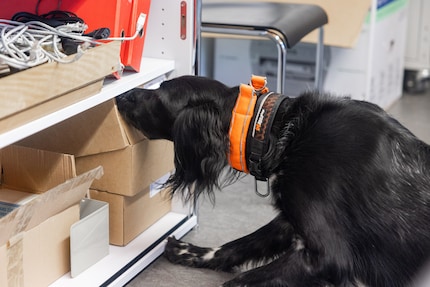
Guggisberg pulls out the box, opens it, unfolds it a few times and retrieves the money from between two layers of cardboard. It’s unbelievable how good the sniffer dog’s nose is. «About a thousand times better than ours,» says Guggisberg and praises Anora. It’s now time for her to take a well-deserved lunch break.

Time for a shift change. While Anora’s making herself comfortable in the dog crate, Jörg Guggisberg gets Diara, a seven-year-old Austrian Black and Tan Hound, out of the car. All we need now is a missing person. Roger Eckert from the Service Dog Centre steps up as a volunteer. «Can you give me an item of clothing?» Guggisberg asks. Eckert passes him a hat. The dog handler places it in a plastic bag, which he immediately seals shut. The odour inside needs to be highly concentrated.
Diara’s hyper focused. Once her search dog harness is on, her hind legs start trembling. I decide to ask an uncomfortable question: «Is police work dog-friendly?» «Absolutely,» Guggisberg says. «The trembling doesn’t mean she’s overwhelmed or afraid. Dogs of her breed want to work. When we’re on holiday, I sometimes even hide my wife to satisfy Diara’s need to be active. She’s itching to finally start searching.» Well then, off we go.
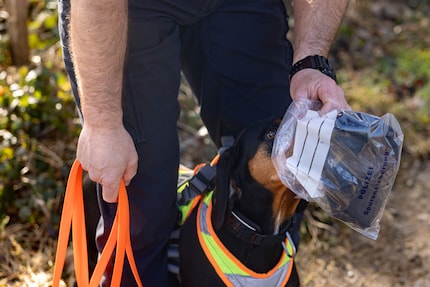
Guggisberg opens the bag containing the hat and pulls it over Diara’s snout. Her eyes widen, her nostrils flare. The dog and her handler stay like this for a few seconds. «Finding people is the most difficult job that search dogs are tasked with. We can’t condition them to a specific smell because the missing person’s is always unique. The only thing for it is to practice, practice, practice.»
Finally, Diara receives her starting signal and dashes off. Snout alternating between the ground and the air above her head, she hurriedly drags her handler up the woodland path. I can barely keep up. «Sometimes, we go on like this for kilometres at a time. You have to be pretty fit,» Guggisberg shouts over his shoulder. I can certainly believe that. As we approach a woodpile on a small hill, Diara picks up the pace again. She veers off the path. And sure enough, there’s Roger Eckert, sitting behind the piled up logs. Diara stays calmly positioned in front of him.
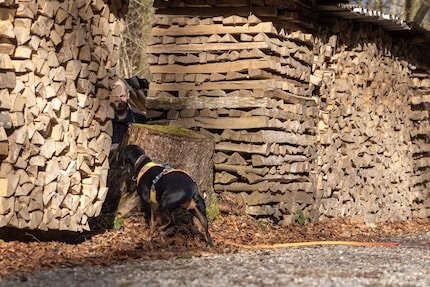
What if Roger Eckert were a criminal needing to be caught? Would Diara bite him? «No, people often get the wrong idea there,» Guggisberg says. «A service dog would hold the person by the legs or upper body with its muzzle. That’d probably cause a few pressure points.» «And what if the person fights back?» I ask. «Then the dog would strengthen its grip. At the police officer’s command, it’d immediately release the person. The goal is to avoid injuries as far as possible.»
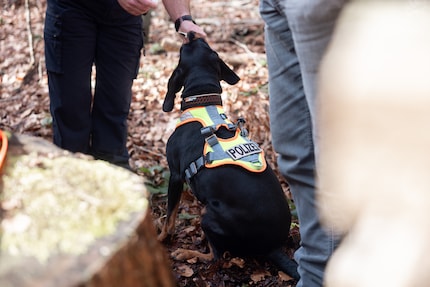
Like Roger Eckert, Diara has already tracked down a number of people – and even saved lives. Take the case of a 94-year-old man who failed to return from a walk, for example. After sniffing the missing man’s undershirt, Diara led her handler up a steep path. «We were all certain the man couldn’t be up there, but we ended up finding him collapsed in a thorn bush. If we hadn’t found him, he probably would’ve frozen to death.»
Today was yet another day of excellent work for Diara. High time for an attagirl from the boss. Guggisberg takes off her harness and gives her a toy. «That’s enough of a reward?» I ask incredulously. «Food is the most important thing to her. But once she’s done with her work, she goes crazy for her toys,» Guggisberg says with a laugh. Diara responds with a snort, shaking the last traces of the hat scent out of her snout. She then goes romping along the forest path towards the dog crate, clutching her toy. Ah, another day, another dollar dog treat!
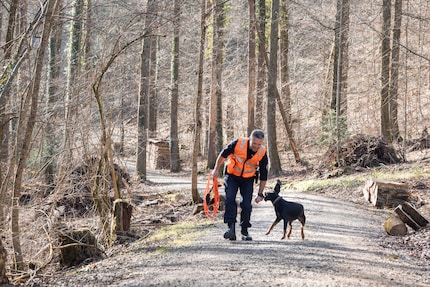
I love anything with four legs or roots - especially my shelter cats Jasper and Joy and my collection of succulents. My favourite things to do are stalking around with police dogs and cat coiffeurs on reportages or letting sensitive stories flourish in garden brockis and Japanese gardens.
Interesting facts about products, behind-the-scenes looks at manufacturers and deep-dives on interesting people.
Show all
Background information
by Darina Schweizer

Background information
by Darina Schweizer

Background information
by Darina Schweizer